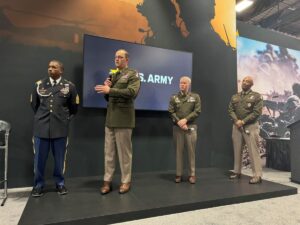The theme at this year’s Association of the U.S. Army (AUSA) Annual Meeting and Exposition left little to the imagination: “Agile, Adaptive, Lethal: Winning at the Pace of Change.” Filling the sprawling Walter E. Washington Convention Center in Washington, D.C., from Oct. 13-15, the event is the premier land power exposition and professional development forum in North America. It attracted more than 44,000 attendees — up from 33,000 in 2024 — including military leaders, GovCon innovators, and decision-makers. It also brought in 750-plus exhibitors to showcase their cutting-edge tech.
AUSA is a nonprofit educational and professional development association serving the Army and U.S. defense supporters. This year, the organization celebrated the Army’s 250th birthday and weathered a concurrent government shutdown.
From the floor, Rebecca Unetic, Director of Growth and Capture at Fuse Integration, commented: “Companies were not expecting much foot traffic given the government shutdown, however, to our surprise, the military came out in droves! So many top brass were there. It was pretty impressive to see how much they showed up for AUSA. The people I spoke with said foot traffic was really good. They had tremendous customer engagements. We also had a lot of very promising business-to-business discussions at AUSA. It was a worthwhile conference!”
Change Afoot

U.S. Army Secretary Dan Driscoll leads the opening ceremony of AUSA 2025. Credit: Association of the United States Army
Plans to drastically change how the Army acquires weapons and platforms were a hot topic this year. Secretary of the Army, Dan Driscoll, hinted at reform coming in a matter of weeks that would mirror Silicon Valley procurement processes.
“We are going to try to mimic what works really well in the private sector,” Driscoll said. “After seeing the power of combining venture capital money and mentorship with startup culture, I can say unequivocally that the Silicon Valley approach is absolutely ideal for the Army.”
The plan is to identify startups, fund them, and get minimally viable products to soldiers in weeks, he added. To do that, the service will “buy small numbers of things, get it in the hands of soldiers, iterate with the company when we think it works pretty well, field it in a division or two, and then when we think it is ready, scale it across the entire Army,” Driscoll said.
The service will continue to rely heavily on the defense industrial base, meeting with GovCon to discuss “what we think we need in the future because we want them to be successful,” he said. “We need that expertise.”
Driscoll pointed to the FUZE initiative, a venture capital-style model, that the Army announced last month. The program will invest $750 million in the next year and increase by $15 million the year after — an “over 150% increase in the Army’s funding towards emerging tech and innovation,” he said.
Command Configuration

Warriors Corner at AUSA 2025. Credit: U.S. Army
The Army is preparing for the Western Hemisphere Command, which will combine the Army North, Army South, and Force commands when it is stood up by year’s end. Fort Bragg will be the command’s headquarters.
“As we received the two [commands], our role changes from GMD [ground-based midcourse defense] … to AMD [air and missile defense],” said Lt. Gen. Sean Gainey, head of the Space and Missile Defense Command. “In that capacity, we now have all elements of the defense of the homeland.”
The change comes as the service readies the Air and Missile Defense Strategy 2040, which will emphasize homeland defense. Army Chief of Staff Randy George and Driscoll will likely approve it next month, Gainey said.
“It’s now more of an architecture approach, where you have several systems with the ability to sense and engage several different places,” Gainey said. “No longer are you going to be just [going to see] a tactical ballistic missile threat. No longer are you just going to [see] a cruise missile threat. You’re going to be in all of that at one time, so you need to have a system of systems approach as opposed to a specific, isolated system approach.”
Next-Gen Tech

Fireside chat at AUSA 2025: “From the Foxhole to the Factory–Achieving Total Battlefield Dominance.” Credit: Association of the United States Army
As it revamps how it acquires products, the Army is also setting new priorities. For instance, it included counterspace capabilities for the first time in its five-year budget — a move that follows the service’s 2024 Space Vision, which emphasized integrating space support service-wide and the interdiction of adversary space capabilities.
“Interdiction is ubiquitous with counterspace,” said Col. Pete Atkinson, space division chief at the Army Strategic Operations Directorate. “What it’s getting at is counter-satellite communications, counter-surveillance and reconnaissance, [and] navigation warfare. How do we protect friendly forces from threats emanating from the air and space domains? It’s really important for the Army.”
What’s more, the Army is in the process of standing up its own space branch, said Brig. Gen. Donald Brooks, deputy commander of the Army Space and Missile Defense Command.
Also in the works is a pilot program, called SkyFoundry, to domestically produce about 10,000 small uncrewed aerial systems each month. The Army Materiel Command is heading the effort, which will rely on innovative manufacturing to rapidly develop, test, and produce the drones.
“We can bring industry in a partnership where we can experiment with their software [and] their payloads. That’s what really matters in a drone, not the plastic and metal that goes into it,” Undersecretary of the Army Michael Obadal said.
And it wouldn’t be a discussion of next-gen tech without AI. Maj. Gen. William “Hank” Taylor, acting commander of Eighth Army in South Korea, said he’s become proficient at using generative AI chatbots. One application is predictive analysis for sustainment, but he hopes to extend use cases to intelligence, too, “to actually then help us predict things.”
With so much change and so much at stake, we will be staying tuned to see what happens at AUSA 2026!
